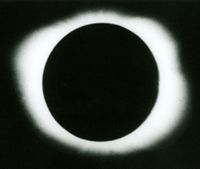Solar Eclipses and Totality
 IN THE DISTANT PAST, the Moon was much closer to the Earth. Thanks to tidal forces and the Law of Conservation of Momentum, the size of the Moon’s orbit has been increasing (currently by ~3.8 cm/yr).¹ As luck would have it, we live in an epoch in which the Moon has an apparent size close to that of the Sun. When near perigee, the moon’s apparent size is adequate to completely cover the Sun. (Unfortunately we do not get monthly eclipses because the Moon’s orbit is tilted about 5° with respect to the ecliptic.)
IN THE DISTANT PAST, the Moon was much closer to the Earth. Thanks to tidal forces and the Law of Conservation of Momentum, the size of the Moon’s orbit has been increasing (currently by ~3.8 cm/yr).¹ As luck would have it, we live in an epoch in which the Moon has an apparent size close to that of the Sun. When near perigee, the moon’s apparent size is adequate to completely cover the Sun. (Unfortunately we do not get monthly eclipses because the Moon’s orbit is tilted about 5° with respect to the ecliptic.)
A total solar eclipse is possibly the most spectacular sight in all of Astronomy. Indeed, many amateur astronomers are eclipse chasers and travel the world in pursuit of their next “fix.”
Of course not all total solar eclipses are equal. During the period –1999 to 3000 the shortest and longest totalities are 9 seconds (919 February 3) and 7 minutes 29 seconds (2186 July 16).² RASC members who travelled to Baja, Mexico in July 1991, experienced 6 minutes 57 seconds of totality; as you can see this is at the upper end of the range of totality durations. The longest total eclipse of this century is already past: 6 minutes 39 seconds on 2009 July 20.
The 20th century brought us the technology to extend totality. A group of observers chartered a plane from Tahiti during the 2010 July 11 eclipse and got an impressive 9 minutes 23 seconds!³ During the 1973 June 30 eclipse a group of observers flew in a Concorde at Mach 2.05 and extended the length of totality to an incredible 74 minutes!4 With the Concorde no longer in service, only supersonic military aircraft are currently capable of replicating this feat, so this record is likely to stand for a long time.
References:
1 eclipse.gsfc.nasa.gov/SEhelp/rotation.html
2 eclipse.gsfc.nasa.gov/SEcat5/catalog.html
3 wired.com/wiredscience/2010/07/eclipse-chasers/
4 nature.com/articles/246072a0
See also:
- walter.macdonald2@gmail.com's blog
- Log in to post comments

Comments
Eclipse 2020
Is anyone going to the 2020 eclipse in Argentina?